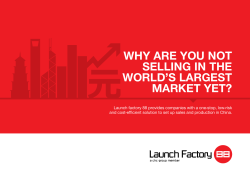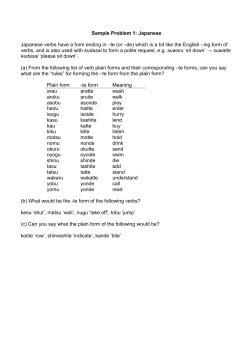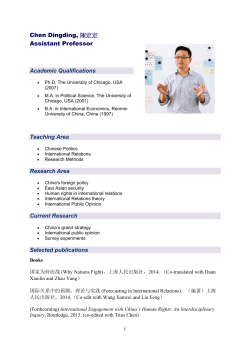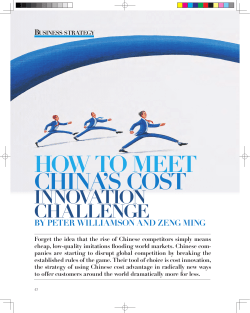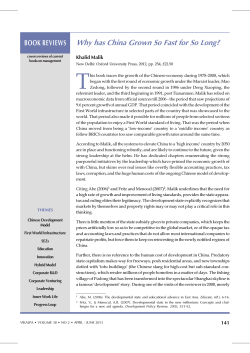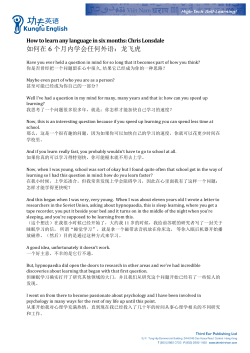
Gianna Pomata - Centre Alexandre Koyré
Gianna Pomata Institute for the History of Medicine, Johns Hopkins University Professeur invitée à l’EHESS, Paris, 18 Janvier - 17 Février 2015 Conférences 1. Mardi 27 janvier, 19h-21h Dans le cadre du séminaire de Rafael Mandressi et Anne Carol, Histoire de la médecine et des savoirs sur le corps EHESS, 105 bd Raspail 75006 Paris, salle 2 THE MEDICAL CASE ACROSS CULTURES: COMPARING THE EUROPEAN OBSERVATIO AND THE CHINESE YI'AN In this lecture, I focus on the history of the case narrative in pre-modern medical cultures, the topic of my forthcoming book. Adopting a crosscultural perspective, I compare the development of the medical case in pre-modern Europe and China. The comparison is based on my own research for Europe, and, for China, on the excellent studies by Charlotte Furth, Christopher Cullen, and other scholars, who have given us a very rich and nuanced description of the genre in the long duration of Chinese medical culture. There are some remarkable similarities between the early modern Chinese and European medical case narratives. In fact, the similarities quite outnumber the differences. In this lecture, I will mostly survey the similarities of the genre in the two contexts, while also briefly considering the main points of difference. I will try to provide a comparative answer to the following questions - what kind of medical practice formed the backdrop for the emergence of the case narrative as a distinct epistemic genre? What explains the similarities between the genre in the two contexts? Were they due to some intellectual contact and exchange between pre-modern Europe and China? Or did the case narrative emerge, develop and flourish in each of the two cultures independently? 2. Mercredi 04 février, 17h-19h Dans le cadre du séminaire d’Antonella Romano, Rafael Mandressi et Jean-Marc Besse, Savoirs et productions du monde au XVIe siècle : Lieux, acteurs, échelles EHESS, bât. France, salle 2 (rdc), 190-198 av. de France 75013 Paris FORMULAS, CASES, AND THE EXCHANGE OF MEDICAL KNOWLEDGE BETWEEN EARLY MODERN EUROPE AND CHINA In this lecture, I examine the exchange of medical knowledge between Europe and China in the early modern period. I consider in particular the translation and transmission of medicinal formulas and pharmacological knowledge, focusing on the Chinese recipes and list of materia medica published in Specimen Medicinae Sinicae (1682), edited by the Dutch physician Andreas Cleyer and presumably translated by the Jesuit Michael Boym. Specimen played a fundamental role in the introduction of Chinese pulse medicine to Europe. Most importantly, the medicinals formulas and materia medica contained in it appear to be the first attempt to transfer Chinese pharmacological knowledge to Europe. Based on my previous lecture, I also consider whether medical case literature circulated between Europe and China. I find that several important European case collections were carried by the Jesuit missionaries to China, and that, conversely, some Chinese case narratives made it all the way to Europe as part of European translations of Chinese materia medica texts. On the whole, however, I find that cases travelled much less well than formulas/recipes between the two cultures. Why? My lecture will try to give an answer to this question. 3. Jeudi 5 février, 14h-16h Dans le cadre de la Transversale genre du Centre de Recherches Historiques EHESS, bât. France, salle 1, 190-198 av. de France 75013 Paris MILK FLOWING FROM VENUS’ BREAST: LACTATION AND SEXUALITY IN THE ART AND MEDICINE OF THE RENAISSANCE In this lecture I examine an allegorical painting by Paolo Veronese, conventionally called “Venus and Mars United by Love” (Metropolitan Museum, New York) and the unusual image of Venus lactans (lactating Venus) represented in the picture. Historians of art have been puzzled by this image, and no satisfactory interpretation has been advanced so far. I offer a new interpretation of Veronese’s Venus lactans in two ways: first, by contextualizing the image in the Renaissance iconography of lactation; second, by examining the understanding of the female breast in 16thcentury medical discourse. In both contexts, pictorial and medical, I argue, the lactating breast was perceived not simply as a symbol of motherhood but as a locus of conjunction of the nutritive and the erotic, the maternal and the sexual. 4. Lundi 16 février, 14h-16h Dans le cadre du séminaire du Groupe d’études sur les historiographies modernes (GEHM), en collaboration avec le Centre Alexandre-Koyré EHESS, bât. France, salle 015 (rdc), 190-198 av. de France 75013 Paris EPISTEMIC GENRES: TOOLS FOR THE CULTURAL HISTORY OF KNOWLEDGE In this lecture, I will discuss the notion of “epistemic genre” and its use for the history of knowledge. While “styles of knowing” have been widely debated by historians and philosophers of science, less attention has been paid to the genres of scientific texts. I propose to call "epistemic" that class of genres which develop in tandem with scientific or cognitive practices - just to give a few examples: the treatise, the lecture, the commentary, the encyclopedia, the textbook, the aphorism, the essay, the medical recipe, the case history, etc. I will argue that the notion of genre has a cognitive, and not only literary, dimension. I will also argue that a focus on epistemic genres can be very useful for the cultural history of science, especially in a long-term and cross-cultural, comparative dimension. I will examine in particular three of the benefits that a focus on epistemic genres may bring to the cultural (and cross-cultural) history of knowledge: a) A better awareness of the long duration in the history of cognitive practices. b) A rapprochement of the social history of practices and the intellectual history of concepts, both indispensable to our historical understanding of knowledge and science, but all too often cultivated as separate enterprises. c) A new perspective from which to examine the issue of inertia versus innovation - a key issue in the history of scientific traditions.
© Copyright 2025




